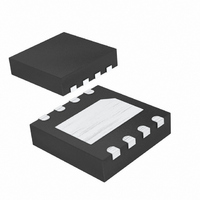MAX1946ETA+T Maxim Integrated Products, MAX1946ETA+T Datasheet - Page 10

MAX1946ETA+T
Manufacturer Part Number
MAX1946ETA+T
Description
IC SW USB SNGL W/FB 8-TDFN
Manufacturer
Maxim Integrated Products
Datasheet
1.MAX1946ETAT.pdf
(13 pages)
Specifications of MAX1946ETA+T
Applications
USB, Peripherals
Current - Supply
40µA
Voltage - Supply
2.7 V ~ 5.5 V
Operating Temperature
-40°C ~ 85°C
Mounting Type
Surface Mount
Package / Case
8-TDFN Exposed Pad
Lead Free Status / RoHS Status
Lead free / RoHS Compliant
The MAX1946 provides an open-drain fault output,
FAULT. Connect FAULT to IN through a 100kΩ pullup
resistor for most applications. FAULT asserts low when
any of the following conditions occur:
•
•
•
The FAULT output deasserts after a 20ms delay once
the fault condition is removed. Ensure that the
MAX1946 input bypass capacitance is sufficiently large
to prevent load glitches from triggering the FAULT out-
put. Limit the input voltage slew rate to 0.2V/µs to pre-
vent erroneous FAULT indications.
To differentiate large capacitive loads from short cir-
cuits or sustained overloads, the MAX1946 has a fault-
blanking circuit. When a load transient causes the
device to enter current limit, an internal counter moni-
tors the duration of the fault. For load faults exceeding
the 20ms fault-blanking time, the switch turns off,
FAULT asserts low, and the device enters autoreset
mode (see the Output Fault Protection and Autoreset
section). Only current-limit and short-circuit faults are
Single USB Switch with Autoreset and
Fault Blanking in Tiny TDFN
Table 2. Current Limiting and Fault Behavior
10
Output Short Circuit
Output Overload Current
(V
Thermal Fault
(T
(V
OUT
J
OUT
The input voltage is below the UVLO threshold.
The switch junction temperature exceeds the
+160°C thermal-shutdown temperature limit.
The switch is in current-limit or short-circuit current-
limit mode for more than 20ms.
> +160
______________________________________________________________________________________
> 1V)
CONDITION
< 1V)
o
C)
• If a short is detected at the output, the switch turns off, and the blanking timer begins. FAULT
• If the short persists during the fault-blanking period, the output pulses at 0.35A
• If the short circuit persists after the fault-blanking period, FAULT goes low, autoreset mode
• If the output voltage rises above 0.5V for 20ms, the switch resets, the output turns on, and FAULT
• Output current regulates at I
• Continuous current at I
• If overcurrent persists after 20ms, FAULT goes low, autoreset mode is enabled, and the output
• If the output voltage rises above 0.5V for 20ms, the switch resets, the output turns on, and FAULT
• A junction temperature of +160°C immediately asserts FAULT low (the blanking timeout period
remains high during the blanking timeout period.
removed before the 18ms short-circuit blanking timeout period, the next ramped current pulse soft
starts the output. FAULT remains high.
begins, and the output sources 25mA.
goes high (see Short-Circuit Response in the Typical Operating Characteristics.)
the blanking timeout period.
fault occurs.
sources 25mA.
goes high (see Short Overload Response in the Typical Operating Characteristics.)
does not apply for thermal faults) and turns off the switch. When the junction cools by 15°C,
the thermal fault is cleared and FAULT goes high. Note that if other fault conditions are present
when a thermal fault clears, those fault states then take effect.
Fault Indicator
LIM
persists until either the 20ms blanking period expires or a thermal
LIM
and the blanking timer turns on. FAULT remains high during
blanked. Thermal-overload faults and input voltage
drops below the UVLO threshold immediately turn the
switch off and assert FAULT low.
Fault blanking allows the MAX1946 to handle USB
loads that may not be fully compliant with the USB
specification. The MAX1946 successfully powers USB
loads with additional bypass capacitance and/or large
startup currents while protecting the upstream power
source. No fault is reported if the switch brings up the
load within the 20ms blanking period. See Table 2 for a
summary of current limit and fault behavior.
Connect both IN inputs together. IN powers the internal
control circuitry and charge pump for the switch.
Bypass IN to GND with a 0.1µF ceramic capacitor.
When driving inductive loads or operating from induc-
tive sources, which may occur when the MAX1946 is
powered by long leads or PC traces, larger input
bypass capacitance is required to prevent voltage
spikes from exceeding the MAX1946’s absolute maxi-
mum ratings during short-circuit events.
MAX1946 BEHAVIOR
Applications Information
Input Power Supply and Capacitance
Typical Application Circuit
RMS
. If the short is











